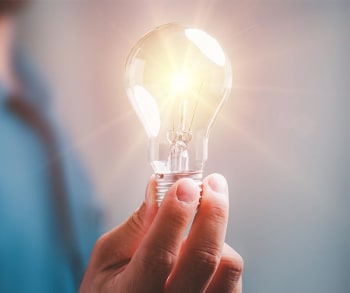SAD & therapy lights
10 ArticlesTo top
SAD & therapy lights – light therapy for your home
Daylight is vital and has a significant impact on our health, sleep and well-being. It controls the interaction of the body's hormones melatonin and serotonin and thus our internal clock – our biorhythm.
Melatonin is known as the sleep hormone and significantly influences the quality of our sleep. The pineal gland releases the hormone, especially in the dark. The longer it is dark, the more melatonin is produced. Serotonin is considered a happiness hormone, wakes us up and has a positive effect on our mood. However, the two hormones are by no means just counterparts, as they are closely interdependent.
The melatonin in the pineal gland is largely formed out of serotonin. If our body receives too little light, the hormone balance between melatonin and serotonin is disturbed. This can lead to sleep problems, daytime fatigue, lack of energy and drive, and even depression.
Especially on dark days and when little natural daylight and sunlight is available to our bodies, this inner balance quickly starts to wobble, and our general well-being is adversely affected. This is where light therapy, also known as bright light therapy, using special SAD and therapy lights, comes in.
SAD & therapy lights – light therapy for your home
Daylight is vital and has a significant impact on our health, sleep and well-being. It controls the interaction of the body's hormones melatonin and serotonin and thus our internal clock – our biorhythm.
Melatonin is known as the sleep hormone and significantly influences the quality of our sleep. The pineal gland releases the hormone, especially in the dark. The longer it is dark, the more melatonin is produced. Serotonin is considered a happiness hormone, wakes us up and has a positive effect on our mood. However, the two hormones are by no means just counterparts, as they are closely interdependent.
The melatonin in the pineal gland is largely formed out of serotonin. If our body receives too little light, the hormone balance between melatonin and serotonin is disturbed. This can lead to sleep problems, daytime fatigue, lack of energy and drive, and even depression.
Especially on dark days and when little natural daylight and sunlight is available to our bodies, this inner balance quickly starts to wobble, and our general well-being is adversely affected. This is where light therapy, also known as bright light therapy, using special SAD and therapy lights, comes in.
What is a SAD lamp?
Bring the sun into your home using Beurer SAD and therapy lights. They give you an extra dose of daylight even on low-light days. Our daylight therapy lamps cover the colour spectrum of daylight very well and create a particularly bright light. As a result, they have a similar positive effect on our bodies as natural daylight and are perfect for effective light therapy.
They help prevent lack of light symptoms and compensate for the effects of the lack of light. This is due to ganglion cells in the retina of the eye. They are light-sensitive and regulate biological processes in the body when light falls on them. Serotonin formation is stimulated, our internal clock is brought back into sync and we feel fitter, revitalised and more balanced.
What is a SAD lamp?
Bring the sun into your home using Beurer SAD and therapy lights. They give you an extra dose of daylight even on low-light days. Our daylight therapy lamps cover the colour spectrum of daylight very well and create a particularly bright light. As a result, they have a similar positive effect on our bodies as natural daylight and are perfect for effective light therapy.
They help prevent lack of light symptoms and compensate for the effects of the lack of light. This is due to ganglion cells in the retina of the eye. They are light-sensitive and regulate biological processes in the body when light falls on them. Serotonin formation is stimulated, our internal clock is brought back into sync and we feel fitter, revitalised and more balanced.
When can SAD and therapy lights help you?
Everybody knows the feeling: On short and often dark days in autumn and winter, we occasionally feel tired and lacking in energy. The signs of lack of light are diverse and are often referred to as winter depression or light depression.
A lack of light can affect anyone. In autumn and winter in particular, it is light late in the morning and dark early in the evening. And sometimes it just doesn't get very bright during the day. For comparison: On a beautiful summer's day, the outdoor light intensity is up to 100,000 lux. In winter, with the sky clouded over, it is only around 2,500 to 3,000 lux.
In addition, we often spend more time indoors in autumn and winter, which can further increase the lack of light. Then when working from home, we tend to retreat into our own four walls and step outside into daylight even less often. As a result, there may be increased signs of lack of light. Surveys in Austria and Switzerland show that around 2.5% of the population there is affected each year.*1
Symptoms that a daylight therapy lamp can help you with:
- Sleep problems
- Imbalance
- Exhaustion
- Mood swings
- Winter depression
- Lack of energy and drive
- Generally feeling under the weather
- Difficulty concentrating
Do you recognise any of the symptoms? Then our SAD lamps can help you with your light therapy. The effectiveness of such a light box has been scientifically proven. The Institute for Quality and Efficiency in Health Care confirms that light therapy can help counter the severity of winter depression and reduce it.*2
When can SAD and therapy lights help you?
Everybody knows the feeling: On short and often dark days in autumn and winter, we occasionally feel tired and lacking in energy. The signs of lack of light are diverse and are often referred to as winter depression or light depression.
A lack of light can affect anyone. In autumn and winter in particular, it is light late in the morning and dark early in the evening. And sometimes it just doesn't get very bright during the day. For comparison: On a beautiful summer's day, the outdoor light intensity is up to 100,000 lux. In winter, with the sky clouded over, it is only around 2,500 to 3,000 lux.
In addition, we often spend more time indoors in autumn and winter, which can further increase the lack of light. Then when working from home, we tend to retreat into our own four walls and step outside into daylight even less often. As a result, there may be increased signs of lack of light. Surveys in Austria and Switzerland show that around 2.5% of the population there is affected each year.*1
Symptoms that a daylight therapy lamp can help you with:
- Sleep problems
- Imbalance
- Exhaustion
- Mood swings
- Winter depression
- Lack of energy and drive
- Generally feeling under the weather
- Difficulty concentrating
Do you recognise any of the symptoms? Then our SAD lamps can help you with your light therapy. The effectiveness of such a light box has been scientifically proven. The Institute for Quality and Efficiency in Health Care confirms that light therapy can help counter the severity of winter depression and reduce it.*2
New power from daylight – this is how Beurer SAD and therapy lights work
Whether a lamp can have a medical effect depends essentially on two factors: The light intensity and the colour temperature. For there to be a therapeutic effect, a light intensity of 10,000 lux is recommended.
For comparison: In a well-lit office, the light intensity is just 500 lux. At the same time, electric light has an increased proportion of red light compared to daylight. Due to the low lux value and the increased red content, conventional electric lamps are therefore not sufficient to have a medical effect.
Beurer SAD and therapy lights can simulate daylight of 10,000 lux, depending on the distance to the device. The colour temperature of the lamps is between 5,000 and 6,500 Kelvin, which roughly corresponds to the characteristic colour temperature of daylight on a sunny day at midday. Thanks to the light intensity of 10,000 lux and the colour temperature in the blue range, our SAD lamps are able to simulate natural light very well. This makes them perfect for light therapy with a medical effect.

New power from daylight – this is how Beurer SAD and therapy lights work
Whether a lamp can have a medical effect depends essentially on two factors: The light intensity and the colour temperature. For there to be a therapeutic effect, a light intensity of 10,000 lux is recommended.
For comparison: In a well-lit office, the light intensity is just 500 lux. At the same time, electric light has an increased proportion of red light compared to daylight. Due to the low lux value and the increased red content, conventional electric lamps are therefore not sufficient to have a medical effect.
Beurer SAD and therapy lights can simulate daylight of 10,000 lux, depending on the distance to the device. The colour temperature of the lamps is between 5,000 and 6,500 Kelvin, which roughly corresponds to the characteristic colour temperature of daylight on a sunny day at midday. Thanks to the light intensity of 10,000 lux and the colour temperature in the blue range, our SAD lamps are able to simulate natural light very well. This makes them perfect for light therapy with a medical effect.

How do I use a SAD lamp correctly?
Our daylight therapy lamps are very easy to use and can be easily integrated into your everyday life.
- Position yourself comfortably in front of the SAD lamp
- During use, you can carry out your usual activities such as reading, working or eating
- Look directly into the light every now and again, as the light is primarily absorbed via the eyes or retina
- However, do not look directly into the light during the entire period of use, as this can lead to overstimulation of the retina
Light therapy using SAD and therapy lights can generally be carried out as often as desired, as its side effects are considered low. For effective use, we suggest using the lamp for at least seven consecutive days. Give it a go and treat yourself to an extra daily dose of light and vitality with our daylight therapy lamps.
How do I use a SAD lamp correctly?
Our daylight therapy lamps are very easy to use and can be easily integrated into your everyday life.
- Position yourself comfortably in front of the SAD lamp
- During use, you can carry out your usual activities such as reading, working or eating
- Look directly into the light every now and again, as the light is primarily absorbed via the eyes or retina
- However, do not look directly into the light during the entire period of use, as this can lead to overstimulation of the retina
Light therapy using SAD and therapy lights can generally be carried out as often as desired, as its side effects are considered low. For effective use, we suggest using the lamp for at least seven consecutive days. Give it a go and treat yourself to an extra daily dose of light and vitality with our daylight therapy lamps.
*1 https://www.iqwig.de/presse/pressemitteilungen/pressemitteilungen-detailseite_9983.html
*2 https://www.beurer.com/web/gb/press/2020/200127_Lichttherapie_IQWiG_EN.php
*1 https://www.iqwig.de/presse/pressemitteilungen/pressemitteilungen-detailseite_9983.html
*2 https://www.beurer.com/web/gb/press/2020/200127_Lichttherapie_IQWiG_EN.php


